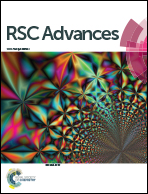Theoretical study on the tailored side-chain architecture of benzil-like voltage stabilizers for enhanced dielectric strength of cross-linked polyethylene
Abstract
A theoretical investigation on the mechanism of the tailored side-chain architecture of benzil-like voltage stabilizers for enhanced dielectric electrical breakdown strength of cross-linked polyethylene at the atomic and molecular levels is accomplished. The HOMO–LUMO energy gaps, the ionization potentials, and the electron affinities at the ground states of a series of benzil-like molecules are obtained at the B3LYP/6-311+G(d,p) level. The 8 isomerization reactions at the S0 state, including the harmonic vibration frequencies of the equilibrium geometries and the minimum energy paths (MEP) found using the intrinsic reaction coordinate (IRC) theory, are obtained at the same level. The substituent group effect, functional group effect, and electronic effect of the different heteroatoms (O, N, S) in substituent groups have been evaluated. The results show that benzil-like molecules, which have much smaller HOMO–LUMO energy gaps, much lower ionization potentials, and much larger electron affinities than those of aliphatic chains, can increase the electrical breakdown strength effectively as voltage stabilizers in cross-linked polyethylene. This result is consistent with Jarvid’s suggestions (Journal of Polymer Science, Part B: Polymer Physics, 2014, 52(16): 1047–1054).


 Please wait while we load your content...
Please wait while we load your content...